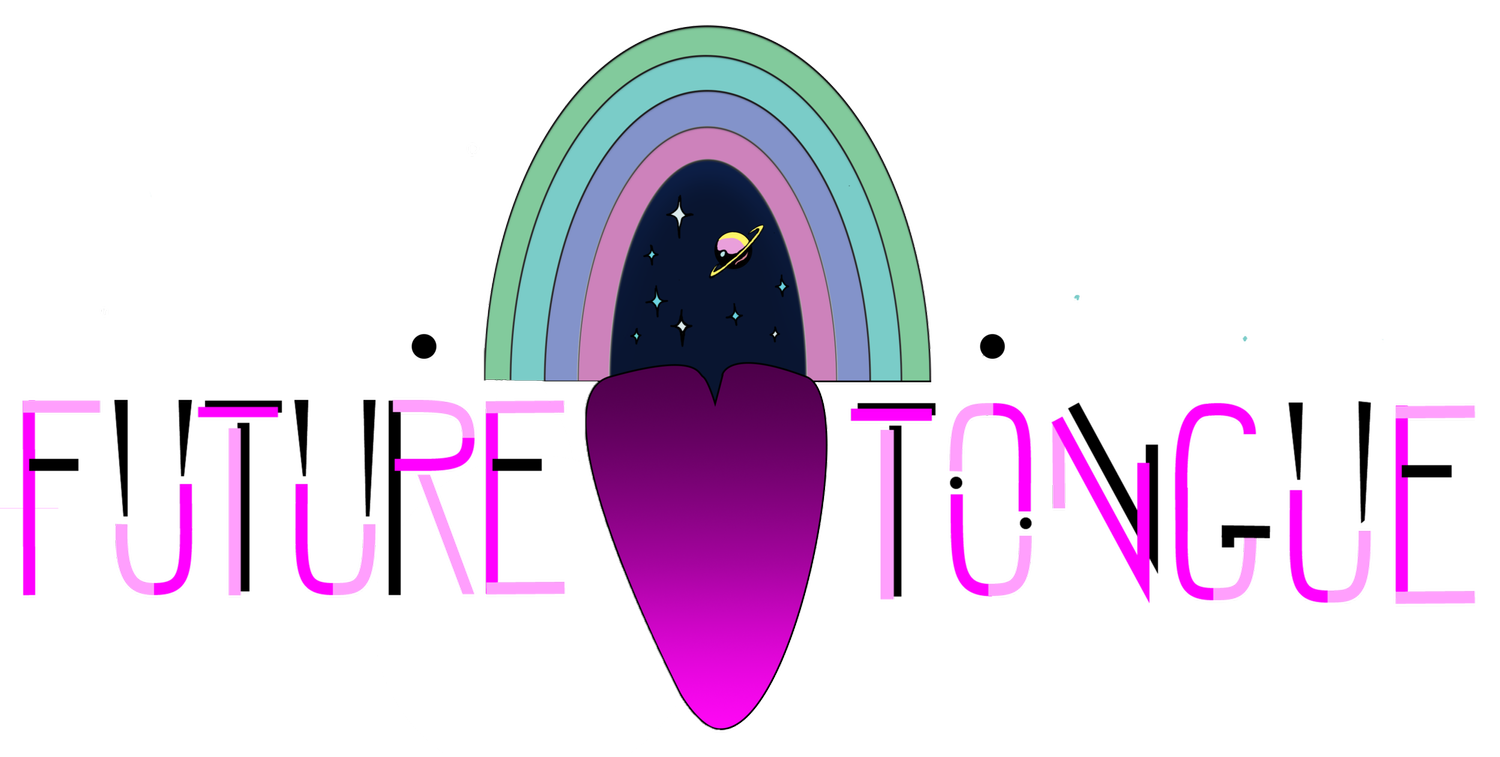NICK BROWN
HIGHLAND PARK, LOS ANGELES
Nick Brown is a painter that lives and works in Highland Park, Los Angeles. He works from his garage in his beautiful well lit home on a hill, with his even more beautiful cat named Trout. Not only is Nick an amazing painter but he is a super rad dude. There is so much to say about his work, but I best let him do the talking. Please go see more images of his work at his website, and make sure you stay on the up and up on all his art events through his facebook and twitter.
Interview by Britt Harrison and videography and photography by Justine Jaime on March 26, 2015.
Inspiration | Subject
They’re all based on these photographs that I take when I go hiking around Mt. Baldy. There’s a hike out there called Ice House Canyon and there are all these remnants of this high mountain community. The only things that are left are these stone chimneys made out of river rock. Presumably, the rest of the buildings were all made out of wood or canvas and they’ve all been destroyed through fires or floods and natural deterioration. So when I first started hiking up there, I found it all really compelling. I think of these chimneys as tombstones or markers of this community that was once there.
Source
The images are all made from my own photographs. To capture the images at night I used two light sources: I had my hiking headlamp and my flashlight. You get all kinds of crazy lighting effects. I hiked up into the mountains at night in a snowstorm, and I was thinking, 'this is probably a bad idea'… [laughs]. I had like 2/3 of a winter hiking kit with me and a big backpack full of crap in case I fell in the river. You’d die from hypothermia in like 15 minutes so I thought I should at least take some equipment. When making the Fragment paintings I select the photograph that I think will make the best painting. I just print the images on printer paper and then tear out several versions of it till I get one that I like. I’m able to adjust the composition from the pieces of the torn print out. Another thing I’ve started doing is making compositions that are comprised of two different print outs of the same image. So you get reoccurring images that strengthen that idea of repetition and collage, and how memory is comprised of fragments that we reconstruct wrong.
Metaphor
I use the snow as a seasonal metaphor for death, which comes from haiku poetry and various philosophies. The paintings are painted in a way to try to demonstrate the deconstruction of the place. That’s why the paint ranges from super super thin with trapped out negative space to a building up in viscosity. Like some areas are slightly over an inch thick, which is the most substantial. As the viscosity gets less and less it starts showing that deconstruction and showing a state of flux. So as a viewer hopefully, you’re receiving the information as it's in some process of becoming or ending.
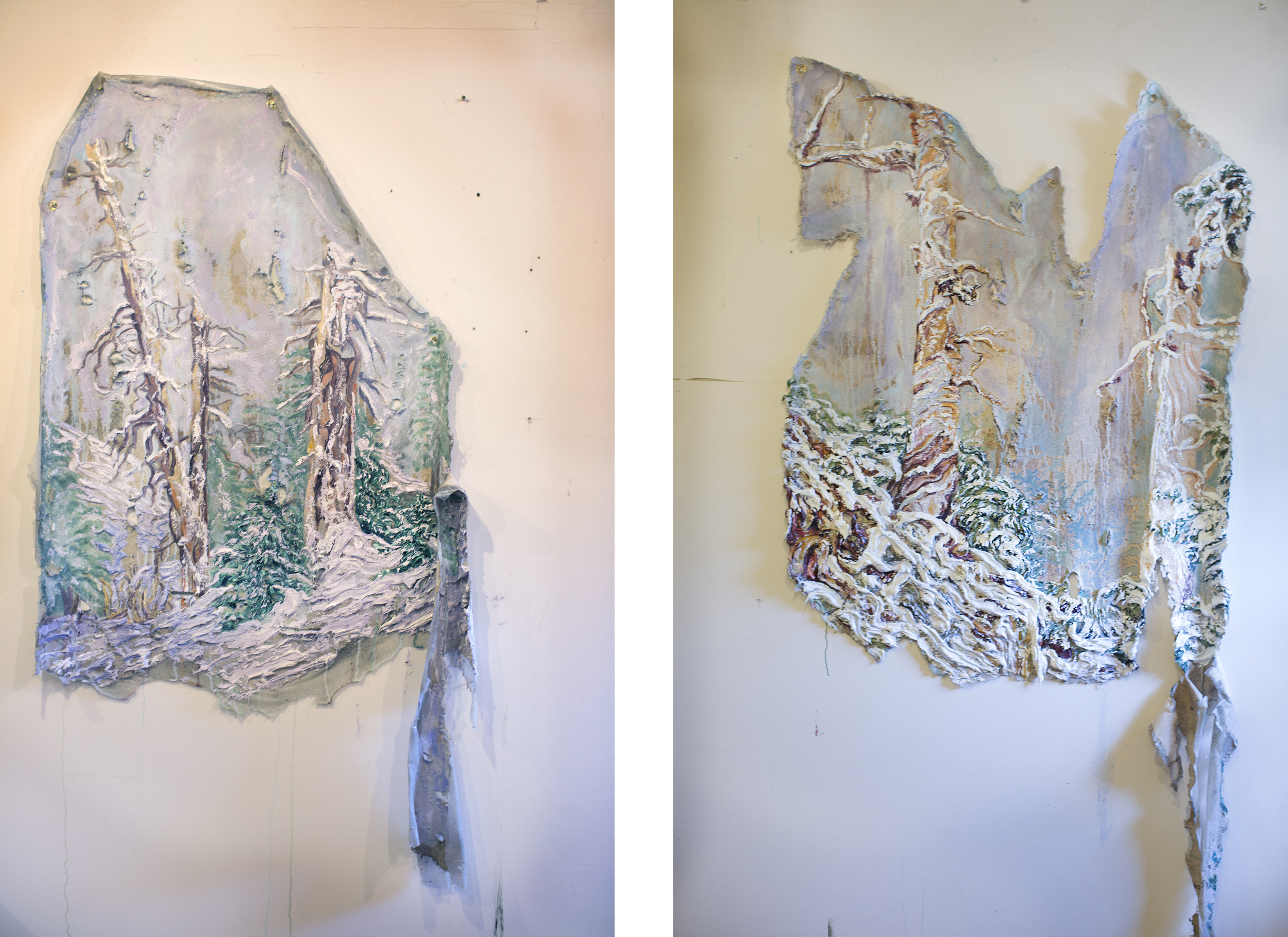
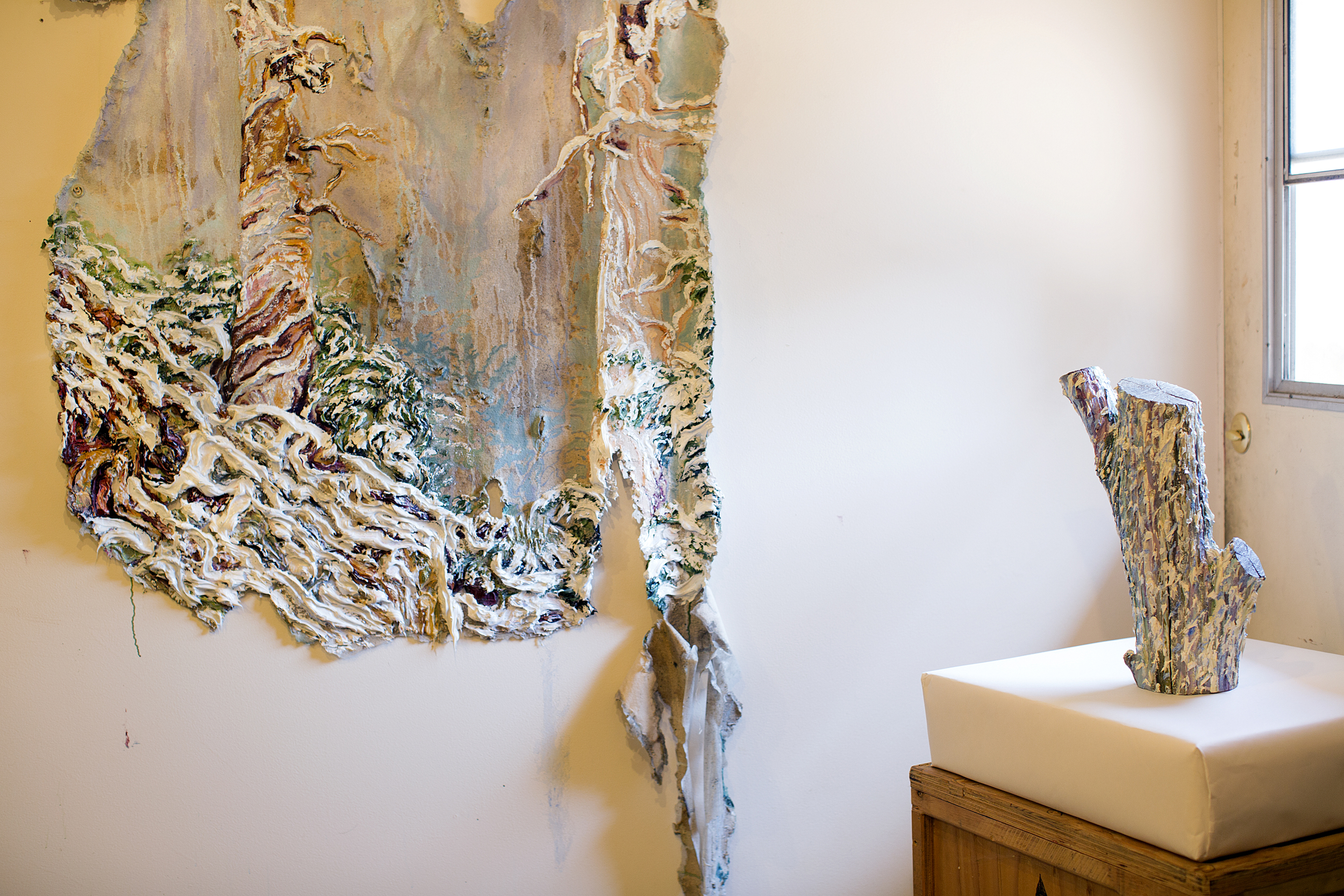
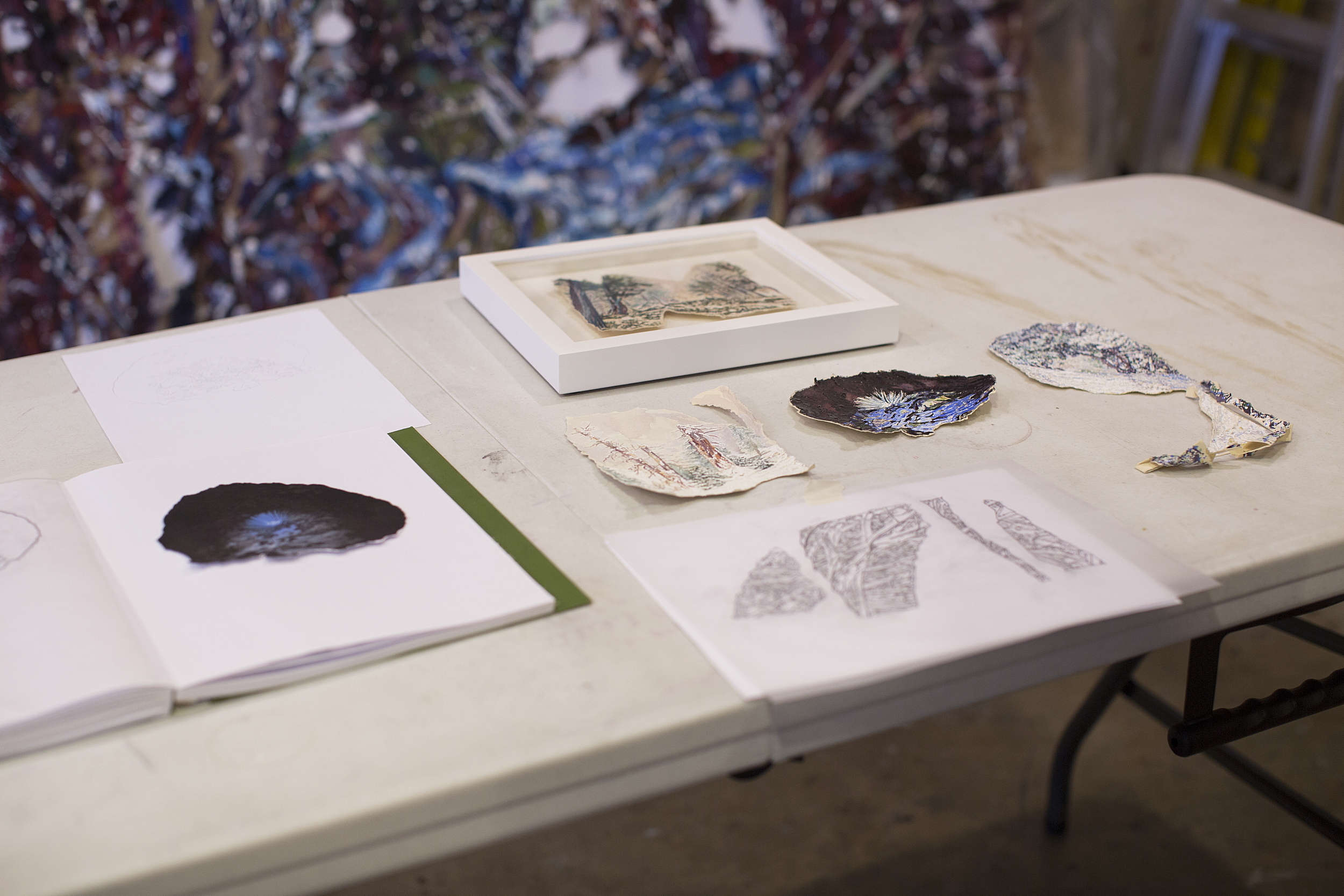
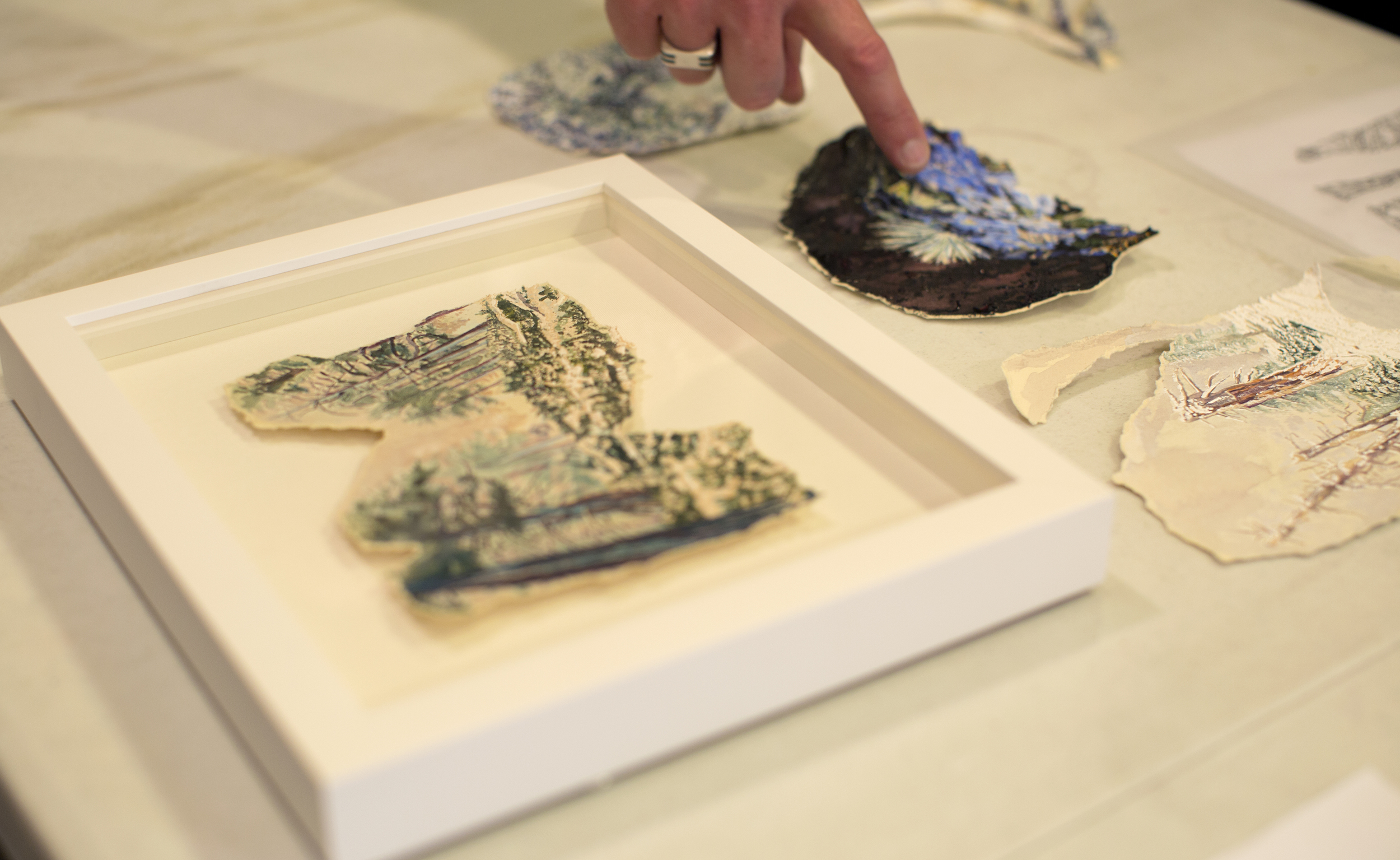
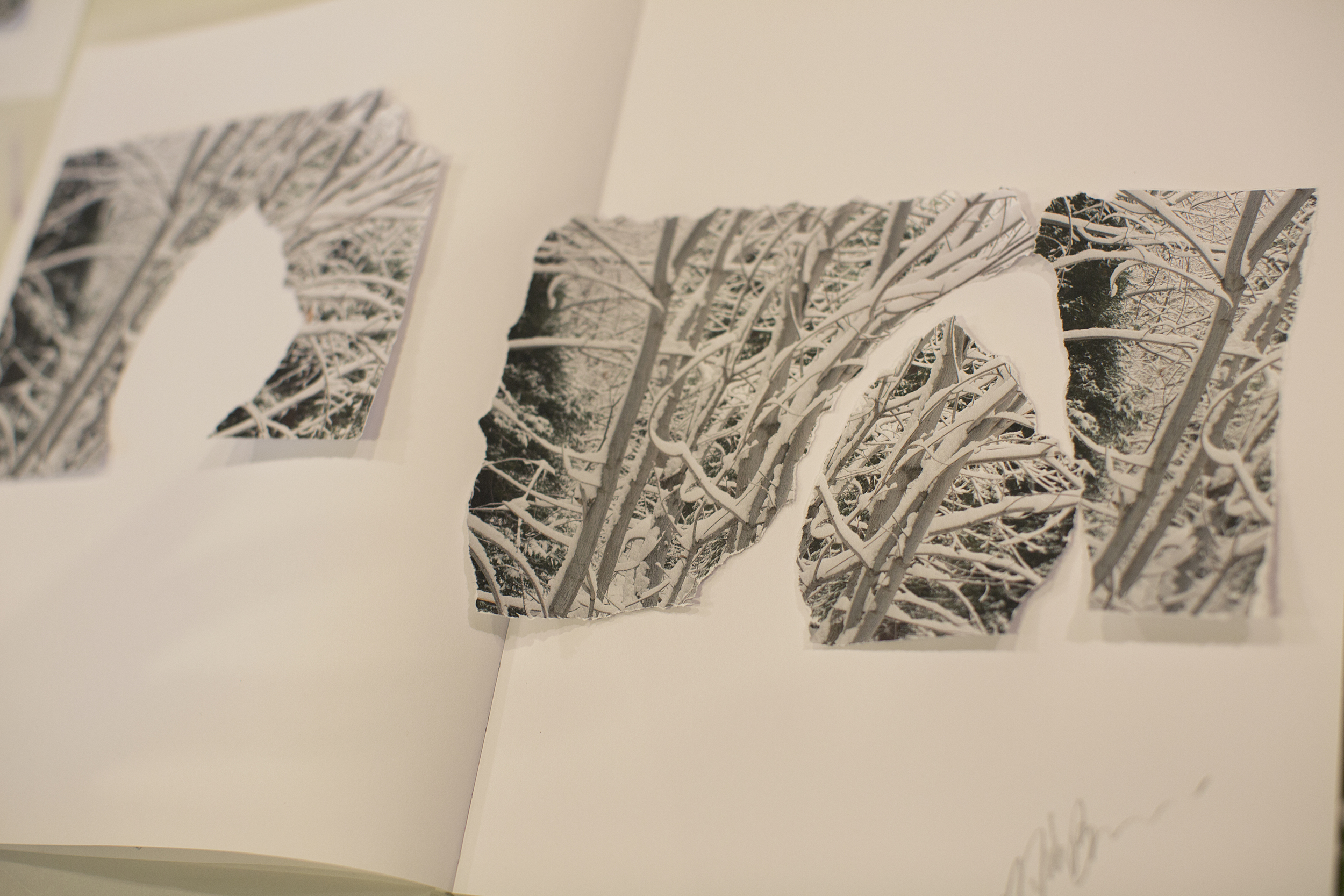

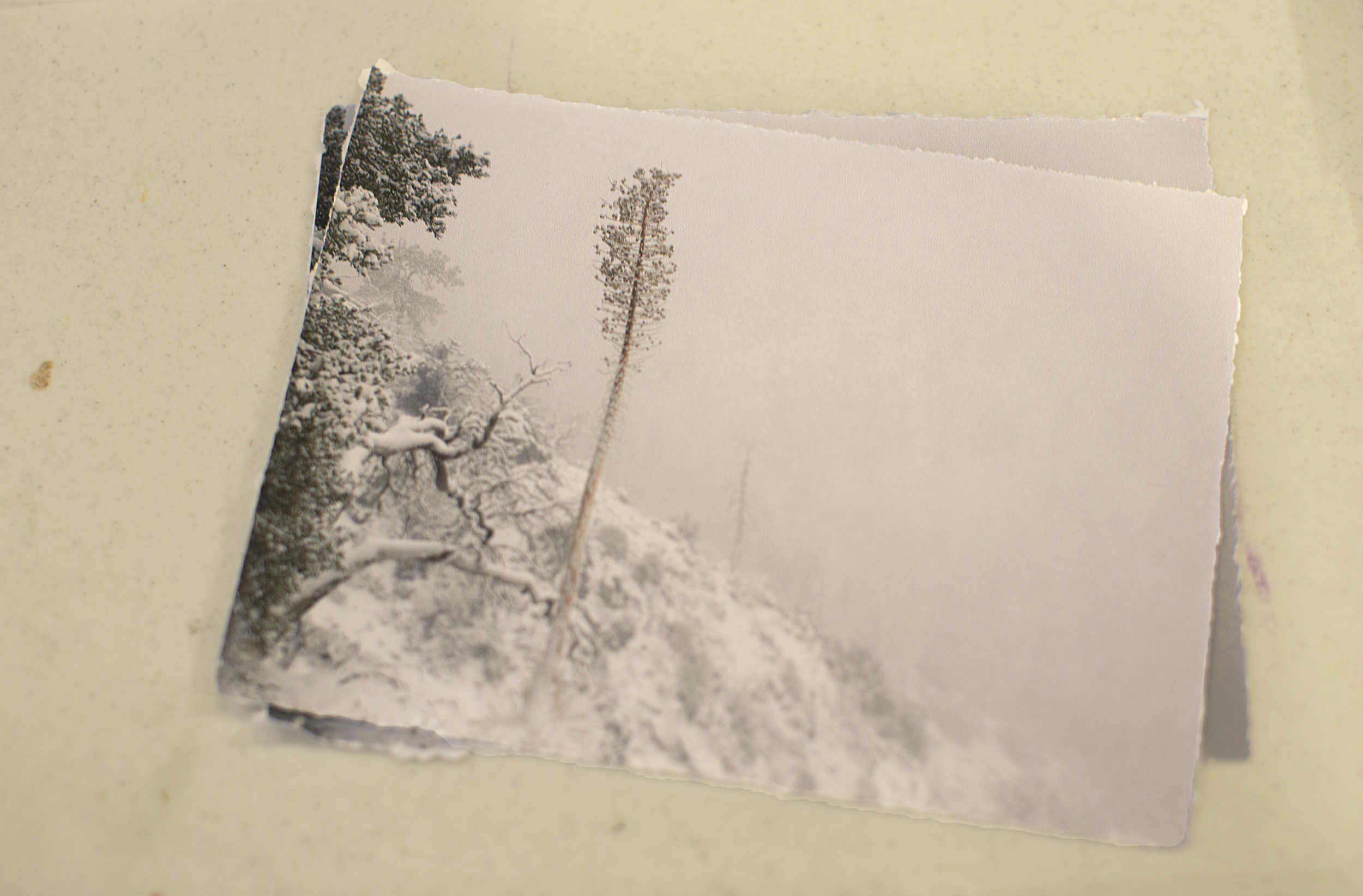
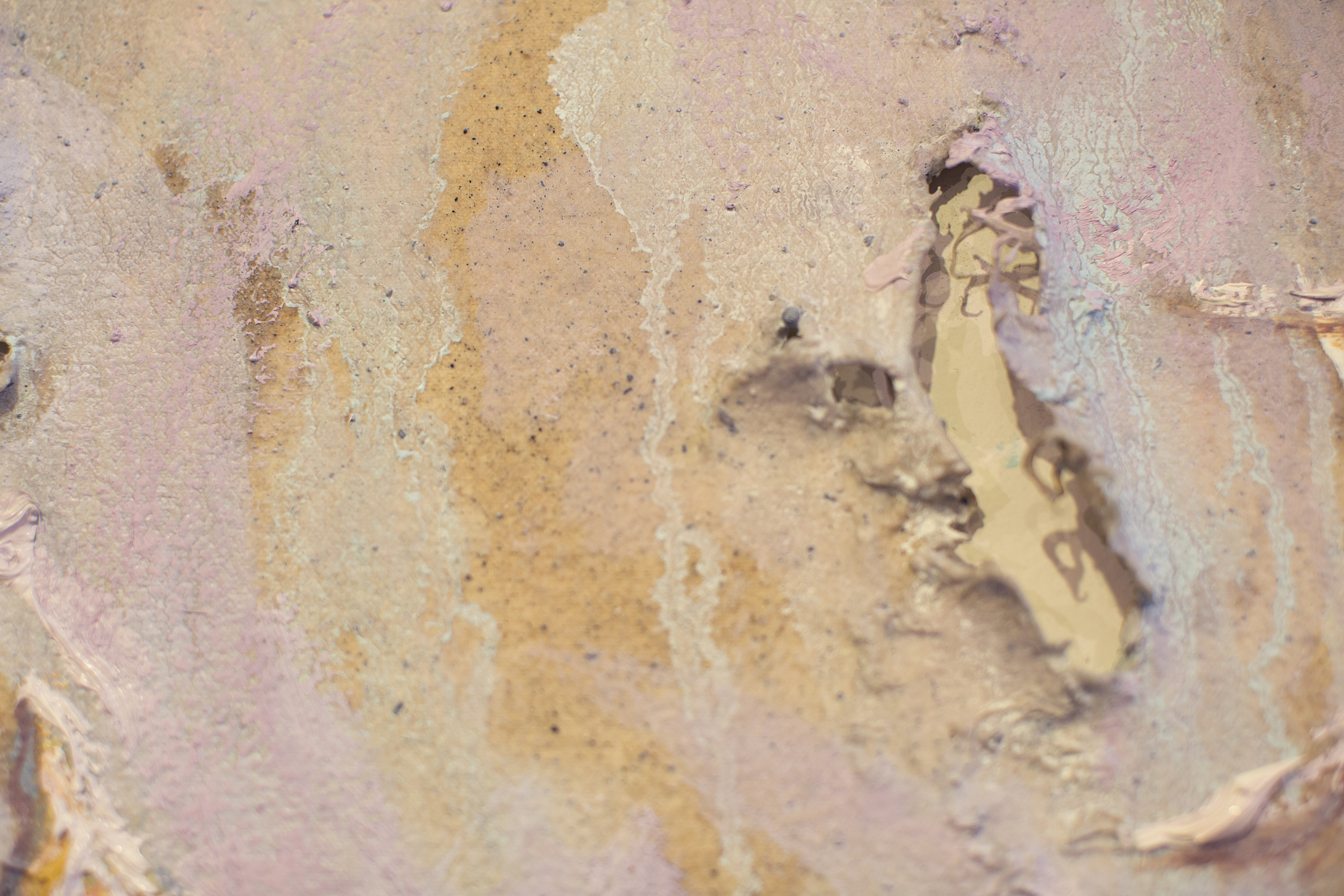
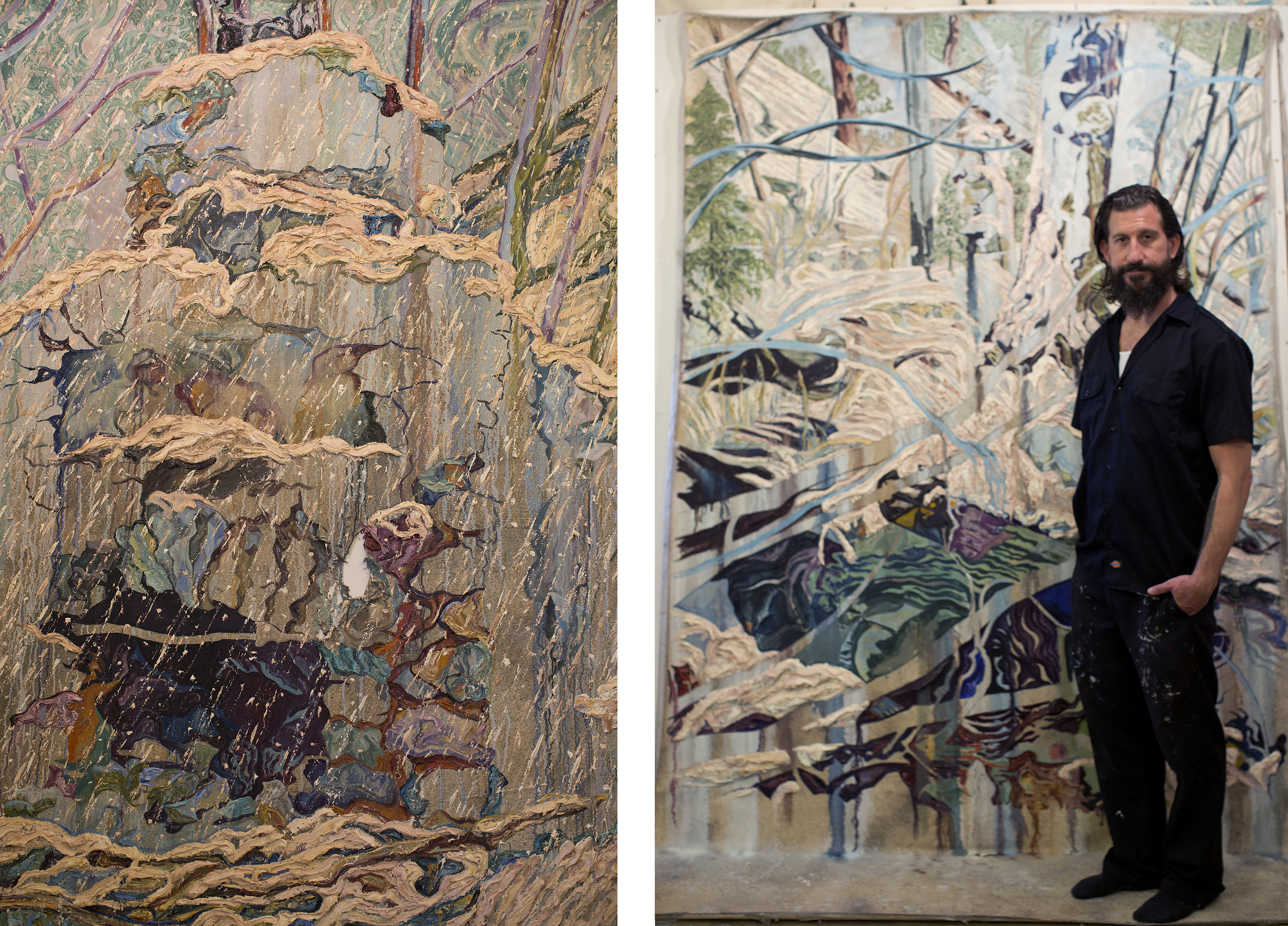
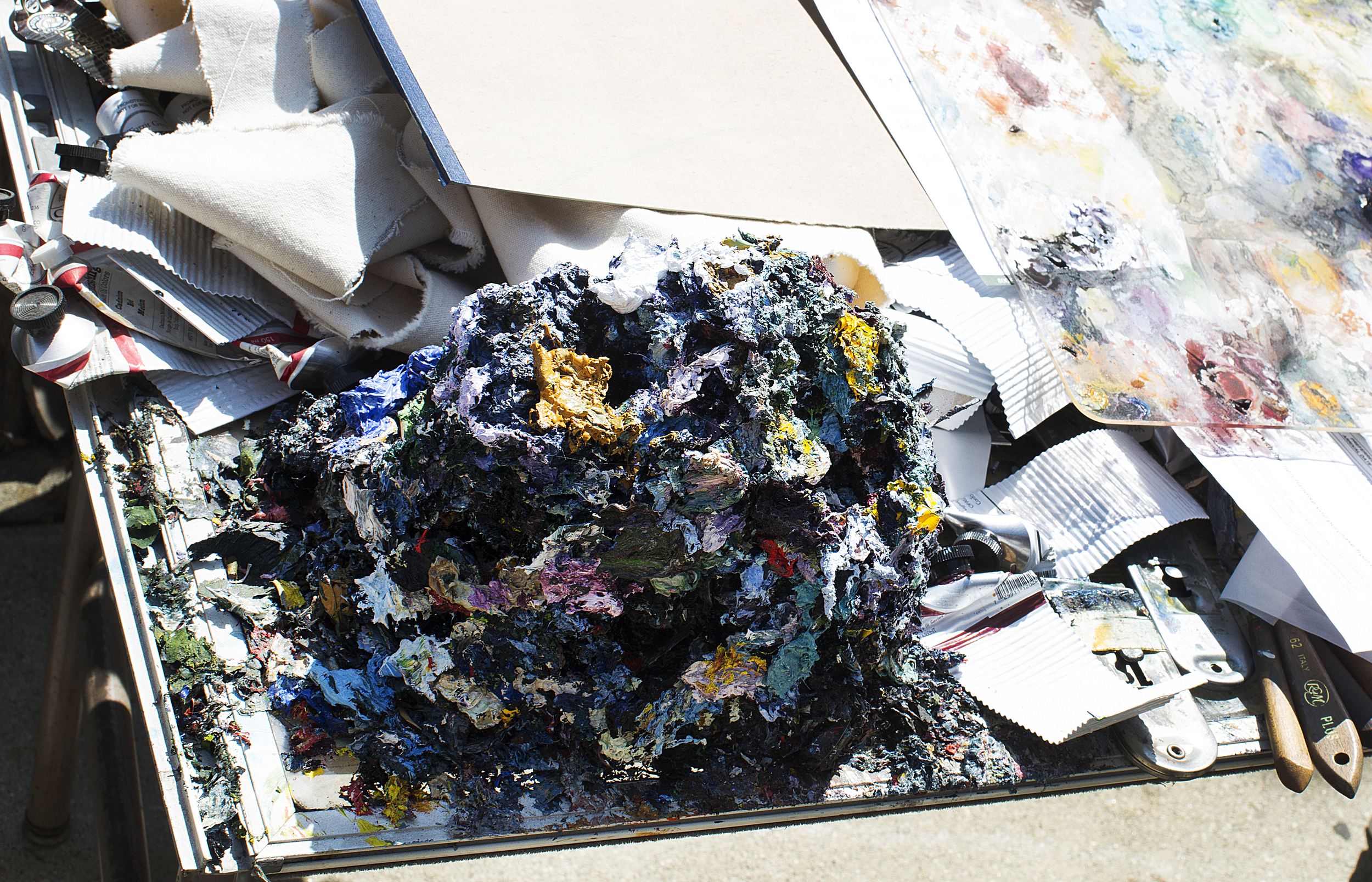
Drawing | Structure
I make a drawing from the photograph and that gets quite manipulated. You can see with all the ruler marks that it looks pretty chaotic, but in the photograph there are trees in these locations. What I’ve done is drawn them down to this nadir so they create this fanning effect, but in reality they're all jumbled in there at any angle. I impose these kinds of compositional structures onto the information in order to make it serve some kind of purpose. I don’t expect you to exactly notice that when you look at the paintings, but I think you intuitively sense that there is some kind of underlying structure. What it also does is it sets up all these parallel planes, so that repetition of form creates some level of harmony and rhythm to what otherwise would be a chaotic environment of jumbled rocks and broken down trees. Then I just free draw the chimneys. So they wind up looking a little wonky, which they are anyways. It helps form this understanding that these things are in a state of collapse.
Watercolor
Along the way I started making these watercolor pieces because I had all this trapped out negative space that needed to be planned out. They started out loose, but I got more and more obsessed with controlling those outcomes. Then the watercolors got tighter and tighter to where they were no longer studies, they were finished things themselves. I also sell these, which has been really helpful, because the large paintings are really inaccessible to most people. I mean they are eight feet tall, which is the standard ceiling height of an apartment or house, but most people don’t have room for it.
Canvas
In the beginning, the canvas gets really heavily stained and then I cut the holes and do the tearing before it gets primed. From the drawing and watercolor work, I know what the painting is going to look like, so when I’m preparing the canvas I can place the holes in direct relation to certain key figures or not. Withering Currents was the first painting to have both the holes and the snowstorm effect. This has been really interesting because the image can survive so many holes. When I first started I was expecting it to really affect the painting, but in that painting you only notice this one big hole. There are at least 75 holes of various sizes in the painting. I’m trying to find the point of failure, like at what point does the substrate literally fall apart. I choose to work on unstretched canvas because it’s adds another layer of deconstruction. It’s not just the imagery that’s deconstructing but also the whole substrate is breaking down.
Withering Currents
2014, Oil on Canvas, 96” x 78” x 20”
Small : Large
After I prime, I project a schematic onto the canvas and I trace it with paint so you also get line work. I use to free draw them and it would take like a week to translate it up from my drawings. These canvases are literally twelve times larger than the original watercolor. Then it just hit me that I should just project these, and now it takes me about four or five hours. So I just lost weeks of work drawing them like that when it made no damn difference since I’m tracing my own drawing anyways. You know what I mean, not that any of its cheating anyhow.
It’s really interesting because I can see you spend a lot of time mixing your paints to get the right colors and then you allow this great interaction between these colors on the canvas.
Yeah, thanks. I do a lot of wet into wet painting, so it looks messy on the canvas. I use a combination of palette knife and brush painting. I also like to use a small palette so my paint mixes with each other before it even gets on the canvas. I found that using a larger palette leaves the paint looking too clean even though I’m mixing like a fist-sized amount of paint. So I also make notes for myself like ‘use a dirty brush, half mixed paint, make multiple passes’, these are reminders to not get uptight. I’m supposed to be painting messy. If I’m mixing this teal color and I want this purplish color to go through it, I mix them independently of each other so I have these two perfect colors. The idea is that they don’t stay perfect but after you spend 30 minutes mixing colors you get a little attached and not of the mind that you’re supposed to be making a mess. So I have all these notes like, ‘hey dick, keep painting with a dirty brush.”
Meta-metaphor:
So I was using snow as a seasonal metaphor for death and I started to think what other kinds of layering could I do to make this metaphor more substantial for this transitioning space and this idea of loss and memory? I started to think about the time of day. So in some, the snow is whiter in appearance and some it’s more of a pink or mauve which is representing that gloaming period when the sun’s setting and it’s reflecting on the snow. Then I extended that to doing these nighttime ones. So these are like the last iteration of these things existing to me. It’s like they’re sitting on the edge of the void in a snowstorm. So I’m using all those layers of information supporting this idea of this thing deconstructing and coming to its natural end.
Fragments:
The purpose of these fragment paintings is not to show you the chimney but they’re sort of like an extended view of the canyon. They’re also heavily deconstructed. They’re not even rectangular anymore, so it’s like that idea of a glimpse or a memory that’s been ripped out of the whole. I also have these object-paintings, which are literally things that occur within the painting like a part of a tree, a river rock, or these Manzanita branches. I paint them to look like exactly how I would paint them if they were in the painting. You get this really strange shift in time and space almost like these objects have fallen out of the painting into our space. Like the tree stump that looks like it’s in a snowstorm, it appears like it’s of another time because it can’t possibly be snowing in our world, inside the studio, but it is snowing in that world.
Installation:
Ideally, if I had a solo show and I could organize all the works together the way I really want to it would make an installation. The large paintings come down onto the floor which then incorporates our space in a more sculptural way and acts as a transition between the room and the image area. The paintings would be arranged from daytime, to the gloaming period, to nighttime. So you have a bunch of whitish paintings turning into to pinkish, turning to black. Then in between the large paintings you would have these fragment paintings which would also give you this movement through the space. The fragments and the sculptures correspond with the time of day as well. I really want to get a Century Plant. They only flower once every 100 years and they send out this huge long stamen kind of thing and once they flower they die. I want to try to acquire one of those that are dead and paint that. It would just sit on the floor and would almost be like an assemblage in relation to the large paintings.
Do you envision your work hanging anywhere else other than a gallery?
Mostly I imagine them in a gallery, museum setting with standard white walls, but I have talked with a few people about installing them in non-exhibition type spaces like maybe a temple. I’m open to the idea of them being in a different kind of venue where the space affects the painting and the relationship transforms the location. I’ve also thought about hiking up to a remote trail where not a lot of people visit and installing a piece there amongst the trees and painting the fat paint. This is something that I’d be interested in doing, but then there’s all sorts of issues like how I would I get it out?
The work is so expressive but you’ve developed this theory to the point of it almost being more conceptual.
Because I have a predetermined structure and composition they are really, in a strange way, quite conceptual paintings. They generally just look like expressive landscape paintings but everything has a rational about why the paint is thick or why the paint is thin. There is so much predetermination that goes into them, so when it actually comes to painting I can paint in a super loose expressive way. That allows for it to have a carefree quality rather than looking super uptight. It’s really important for me to do all this preliminary work which most contemporary artists don’t seem to do. Obviously, for hundreds of years people did tons of preliminary work before they even started on the final piece. I noticed the more I worked on the preliminary stuff the better the work got.
Experimentation
It’s just about allowing yourself to use different methodologies to find different outcomes. I actually now paint from light to dark like you would when creating a watercolor painting, but traditionally in oil painting that’s unconventional. I was always taught to paint dark to light. Then one day I started experimenting and it dramatically improved my work to reverse that process.
When did you start developing this style?
At the very end of 2012 was the first one. I did a loose watercolor study for the painting and then I thought; ‘Yeah, ok I’ll just jump right into it.’ But as the negative space became more and more complex the drawing and the watercolor studies had to become more complex. It was just a natural progression towards this process. And it just keeps growing. I didn’t imagine that I'd be making these fragments or these object paintings but the new ideas come from making the work. It's not some outside influence, you’re just in the process of making things and new ideas occur to you. I’m constantly trying to figure out how to further articulate my ideas. Not add more ideas but strengthen the ideas that I’ve got
Were you working on something similar to this when you were getting your MFA?
I was actually making conceptual wall drawings when I was doing my MFA, and I continued that for several years after I graduated. I had actually good success with that. It’s interesting how making the installation based wall drawings have influenced these. The allowances I took working in that way made it seem natural that these canvases could be unstretched and come onto the floor. So its been really interesting how all the different iterations of work that I’ve made over the years have now arrived at one way of painting.
How did you get from wall drawings back to painting?
I was in NYC during 9/11 and about a year after that happened I decided that I didn’t want to make the installation work anymore. It had an emotional and very personal component to it but it was only after all this logical reading of the work that you would arrive at the emotional thing. It just felt really indirect and cold given the tone of what was happening. So I wanted to return to painting, which is super direct and expressive. I made these pure abstract landscapes so it was like taking the idea of modernism which flattened everything out and got rid of a naturalistic sense of light and atmosphere. I’ve always kind of lamented that that had been removed from modernist painting. So with those paintings I wanted to paint in a non-objective, modernist way but have a sense of atmosphere and space. Now those ideas are in these paintings through the way that I paint super loosely. All my paint marks are non-objective paint marks, but the accumulation of them renders an image. Now the paintings are super atmospheric. I’m doing like non-objective painting that culminates into some recognizable form. It's like it was just necessary for me to go through all these other bodies of work to get to this point.
I see this common thread of death, and the life cycle of things. Do you paint human figures in that way?
Yes, some of the paintings were figurative in the body of work I was working on just prior to this Ice House series. All of my work is ultimately rooted in ideas around death, so loss and memory play into it as well. That’s when I was just starting to use trapped out negative space and ideas like that but most of them were stretched. Then they became unstretched like this one, it’s a self-portrait but it’s defined in these other parameters. It’s my exact height and width and the portion that comes out onto the floor is the exact length of my feet. I liked the idea of this flayed head, it’s kinda of like minus the façade of a portrait. It’s become more psychological
To Scale (Self-Portrait)
2012, Oil on Canvas, 73” x 23 ¾” x 10”
Especially with that sword next to it.
Haha, I know there is a nice relationship there but it happens to just be a handy hanging place. It’s actually a family heirloom. My family is English and it’s a British naval cutlass, the stamp on the hilt is from 1833.
And this painting is called A Shitty Black Door, when it’s hung properly it's like a small, five foot door. When I made that painting I was feeling like I wasn’t quite getting at what would become these Ice House paintings. I was just working through a lot and I started thinking how shitty it is trying be an artist. You know, it's like the worst hobby in the world. You spend all this money on it and you almost never make any money off it and you just berate yourself the whole time. It’s not like someone who goes fly fishing and they tie their own flies and they go sit in their boat or whatever they're doing. Even if they don’t catch anything they are still having a nice time. I doubt they go home and beat themselves up over having a bad day of fishing. So I was lying there and I thought, its like walking through a shitty black door. You walk through it and you just diminish yourself. Then I thought, wait a minute that’s a pretty good idea for a painting [laughs]. So I made it this small-scale door. It’s the idea of the psychological effects of passing through that door. That was kind of a precursor to my current work
A Shitty Black Door
2012, Oil on Canvas, 61” x 26 ¼” x 10 ¾”
So you’re still teaching yourself things?
Yeah, all the time. Every painting I think, what can I do in this painting that I haven’t done in any other painting? I think that is really important. It seems like from looking at a lot of other peoples work they are mostly concerned about consistency. Like they need to make twenty paintings to make a body of work, or whatever the preconceived number is. They’re so concerned with the work reading like a series that every painting is the same. Which of course galleries love, but let's say that takes you a year, then you haven’t actually progressed as a painter for a whole year. You’re refining but you’re not progressing. I work the opposite way, where there is enough consistency already here with the scale, format and subject that I can look for an opportunity to expand what I’m doing. That doesn’t always happen, but being open to it failing I think is really important. These paintings already have a thousand dollars worth of paint on them before I get to the snowstorm effect. The paintings are finished and perfect before I add the white paint, so if that doesn’t work then I’ve just destroyed like seven weeks worth of work
Language So through the context the white reads like a snowstorm or rain, but it’s non-objective painting. It’s just slash marks, right? So it’s this layer of ab-ex painting over expressive image based painting. It’s another language. In a weird way I think of these as language paintings where they’re forming a homogenous image. Normally in language paintings the languages are all separated out and are meant as a commentary on each other. We relate the languages together to create some kind of narrative or concept. However in these, they’re serving a homogeneous image-based purpose yet they’re all separate languages. Like the gestural abstraction and rendering, those are diametrically opposed languages and I’m forcing them together to give a sense of atmosphere and orientation in space.
So you really valued your time at grad school? You feel like its something that you would advise other artists to do?
I found it really, really informative but sometimes I feel like some of the things I learned in grad school should have been a part of the undergrad education. It's too separated out as to what you can manage. A lot of graduate studies is just learning strategies of working and developing ways to think about how to make work and it doesn’t really require a higher education to be exposed to those kinds of ideas. That to me should be foundation level and it's not. Foundation level is just technical drafting skills. I feel like you can learn that at the same time as you're learning how to conceptually develop a piece or a whole body of work. Because they’re not separate things. It’s always going to require a technical facility to make whatever it is that you’re making so you might as well start teaching people to think about how to make their work rather than making you draw this crap still life that you’re disinterested in anyway. But for me grad school was about being able to work pretty much every single day and developing that studio rigor that I still have. I paint almost every single day, so about 40 hours a week and I’ve been out of graduate school for about fifteen years now.
I know you’re teaching at UCLA, do you work anywhere else to support your lifestyle?
Yeah, I teach one class at UCLA and I do private lessons and I’m able to pay for everything with that [laughs]. When I lived in New York I worked like four or five jobs at a time. I taught three days a week at a private art school, one day a week at Pratt Institute and I bartended four nights a week. Sometimes I still needed some extra money! It wasn’t that I was spending all this money, it was just so expensive there. So I would pick up work unloading freight with guys from the projects. There was a few days a month where I would work like 27 hours straight and I would still manage to paint like 30 hours a week.
Was your mindset very different at that time?
Yeah it was very inward looking. Then I moved out here. I found I was very outward looking. So the ab-ex landscape paintings I was talking about were really more like these internal psychological paintings. It was a pretty rough time, so they were quite bleak. My work is still rooted in those concepts but I’m using a lot more external information to express those ideas which makes it way more accessible. I mean we’re all human beings and we all have these similar experiences, we’ve all interacted with nature at some point so it’s a common reference and metaphor.
Do you feel like it was easier for you to break into the art scene in LA compared to New York and even healthier in a way?
Yeah, definitely. My parents live about an hour outside of LA and when I would come and visit them and see galleries I always felt that the scene here was way more accessible. I mean you’d always see the dealer on the floor and you could be like ‘Hey, how’s it going?’ and ask them questions. But in New York you go to a gallery and they make you feel like you’re robbing a bank.
Did you notice a difference in the artwork being shown?
Yeah, the artwork in Los Angeles seemed like every artist was exploring their own unique interests, and I would go back to New York and it was like there might be two or three different types of art being made. Part of the problem I think is that New York is so expensive for the galleries and for the artists so the galleries would have to show work that is quite accessible and salable because they have to pay this enormous rent. It just becomes this big cycle to where there is not as much experimental work being shown.
That exists here too.
But to a much less degree because you can get studio space for a dollar a square foot here and studios in New York are like three bucks a square foot. And they’re in the most remote places, like the last studio I had in NY was in Bushwick, which is now the place to be, but there was nothing there when I was there. I had this shitty little studio with no heat and no air-conditioning. It’s much different now. Same with Williamsburg, now it’s hipster heaven or whatever. It’s just so much easier here, because you have more financial freedom. You can even work outdoors. I’ll set up my drafting table outside for several months because we’re not going to get any rain. There are possibilities here like that, where in New York, and I don’t think I’m just speaking for myself; it starts to feel really closed down.
Big ol' thanks to Nick Brown for his thoughts and enlightenment! Keep you're eyes peeled for his up coming shows! If you see him, make sure you give him a big hug for us and tell him that Future Tongue loves him!
